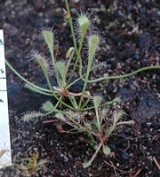
Drosera nidiformis
Encyclopedia
Drosera nidiformis is tropical Africa
n sundew
. This plant is indigenous to South Africa
. Its classification is ambiguous; some sources refer to it as a synonym of Drosera dielsiana
whereas others treat it as a separate species. This plant was previously known as Drosera "maglisburg".
, or acting in response to a touch stimulus.
. It is a perennial plant
. D. nidiformis, like most carnivorous plant
s, grows in nutrient-poor, acid
ic soil. If all growing conditions are not ideal, flowering has an exhausting effect on the plant.
Africa
Africa is the world's second largest and second most populous continent, after Asia. At about 30.2 million km² including adjacent islands, it covers 6% of the Earth's total surface area and 20.4% of the total land area...
n sundew
Sundew
Drosera, commonly known as the sundews, comprise one of the largest genera of carnivorous plants, with at least 194 species. These members of the family Droseraceae lure, capture, and digest insects using stalked mucilaginous glands covering their leaf surface. The insects are used to supplement...
. This plant is indigenous to South Africa
South Africa
The Republic of South Africa is a country in southern Africa. Located at the southern tip of Africa, it is divided into nine provinces, with of coastline on the Atlantic and Indian oceans...
. Its classification is ambiguous; some sources refer to it as a synonym of Drosera dielsiana
Drosera dielsiana
Drosera dielsiana is a compact rosetted sundew native to South Africa, Mozambique, Malawi, and Zimbabwe. It was described as a new species by Arthur Wallis Exell and Jack Rodney Laundon in 1956. The chromosome number is 2n=40. It was named in honor of Ludwig Diels, the author of the 1906 monograph...
whereas others treat it as a separate species. This plant was previously known as Drosera "maglisburg".
Description
Leaves on mature specimens are obovate and range from 1 to 2 cm in length. Petioles can grow 1.5 to a maximum of approximately 5 cm. D. nidiformis exhibits a reddish tint if grown in the correct light conditions. Upon capture of prey, the leaf curls around it to bring it into contact with as many digestive glands as possible. This is an example of thigmotropismThigmotropism
Thigmotropism is a movement in which an organism moves or grows in response to touch or contact stimuli. The prefix thigmo- θιγμος comes from the Greek for "touch". Usually thigmotropism occurs when plants grow around a surface, such as a wall, pot, or trellis. Climbing plants, such as vines,...
, or acting in response to a touch stimulus.
Growth habit
As a tropical plant, D. nidiformis does not tolerate cold temperatures, and will not enter dormancyDormancy
Dormancy is a period in an organism's life cycle when growth, development, and physical activity are temporarily stopped. This minimizes metabolic activity and therefore helps an organism to conserve energy. Dormancy tends to be closely associated with environmental conditions...
. It is a perennial plant
Perennial plant
A perennial plant or simply perennial is a plant that lives for more than two years. The term is often used to differentiate a plant from shorter lived annuals and biennials. The term is sometimes misused by commercial gardeners or horticulturalists to describe only herbaceous perennials...
. D. nidiformis, like most carnivorous plant
Carnivorous plant
Carnivorous plants are plants that derive some or most of their nutrients from trapping and consuming animals or protozoans, typically insects and other arthropods. Carnivorous plants appear adapted to grow in places where the soil is thin or poor in nutrients, especially nitrogen, such as acidic...
s, grows in nutrient-poor, acid
Acid
An acid is a substance which reacts with a base. Commonly, acids can be identified as tasting sour, reacting with metals such as calcium, and bases like sodium carbonate. Aqueous acids have a pH of less than 7, where an acid of lower pH is typically stronger, and turn blue litmus paper red...
ic soil. If all growing conditions are not ideal, flowering has an exhausting effect on the plant.

